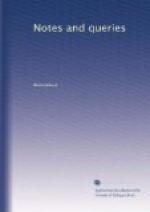Why Moses represented with Horns.—Your correspondent H.W. (Vol. i, p. 420.) refers the origin of what he calls the strange practice of making Moses appear horned to a mistranslation in the Vulgate. I send you an extract from Coleridge which suggests something more profound the such an accidental cause; and explains the statement of Rosenmueller (p. 419.), that the Jews attributed horns to Moses “figuratively for power:”—
“When I was at Rome, among many other visits to the tomb of Julius II, I went thither once with a Prussian artist, a man of great genius and vivacity of feeling. As we were gazing on Michael Angelo’s Moses, our conversation turned on the horns and beard of that stupendous statue of the necessity of each to support the other; of the superhuman effect of the former, and the necessity if the existence of both to give a harmony and integrity both to the image and the feeling excited by it. Conceive them removed, and the statue would become unnatural without being supernatural. We called to mind the horns of the rising sun, and I repeated the noble passage from Taylor’s Holy Dying. That horns were the emblem of power and sovereignty among the Eastern nations; and are still retained as such in Abyssinia; the Achelous of the ancient Greeks; and the probable ideas and feelings that originally suggested the mixture of the human and the brute form in the figure, by which they realised the idea of their mysterious Pan, as representing intelligence blended with a darker power, deeper, mightier, and more universal than the conscious intellect of man; than intelligence—all these thoughts passed in procession before our minds.”—Coleridge’s Biographia Literaria, vol. ii. p. 127. edit. 1817. {92}
[The noble passage from Taylor’s Holy Dying, which Coleridge recreated, is subjoined.]
“As when the sun approaches towards the gates of the morning, he first opens a little eye of heaven, and sends away the spirits of darkness, and gives light to a cock, and calls up the lark to matins, and by and bye gilds the fringes of a cloud, and peeps over the eastern hills, thrusting out his golden horns like those which decked the brows of Moses, when he was forced to wear a veil, because himself had seen the face of God; and still, while a man tells the story, the sun gets up higher, till he shows a fair face and a full light, and then he shines one whole day, under a cloud often, and sometimes weeping great and little showers, and sets quickly; so is a man’s reason and his life.”
—Jeremy Taylor’s Holy Dying.
C.K.




